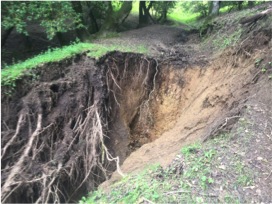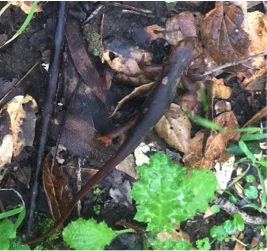O in the Oaks 2017 – Day 2
Briones Regional Park
Date: (Sun.) Mar. 26, 2017
Location: Lafayette, CA
Event Director: - 510.684.2001
Course Setter: Gavin Wyatt-Mair
Type: A; 2017 U.S. Ultra Long championships for all age classes, and recreational courses for beginners
Related Event Information
Event Results PDF File With These Notes O in the Oaks 2017 Overview O in the Oaks 2017 Day-2 Info
Course Setter's Notes
By
Welcome! Briones Park in Spring is beautiful. The grass is green, the wildflowers are abundant, the birds and animals are enjoying themselves, and nature is generally at her best!
The Courses
The courses are designed to test rough-navigation skills, provide many route-choice options, and to test endurance. It is important to read ahead and plan your routes carefully, as there might be big differences between optimal route choices and other route choices. Leg lengths vary from very short to very long.
There are butterfly loops on some of the advanced courses that make extra use of some of the more interesting and flatter areas of the park. The wings of the butterfly loops must be taken in the order shown on your map. Not all maps of a given course have the same wing ordering, so it might not be wise to follow your competitors in a butterfly. Nevertheless, all runners on a given course will run the same course legs—just not necessarily in the same order. The number of controls on courses with butterfly loops is high, so you might need a high-capacity SI stick for those courses (you will definitely need one for the Blue course—see the main event page for details).
Here are the course details:
Navigational Butterfly
Course Length Climb Controls Difficulty Loops
White 3.3 km 120 m 4.1% 9 Beginner
Ultra Yellow 4.4 km 150 m 3.4% 8 Advanced Beginner
Ultra Orange 6.5 km 300 m 4.6% 13 Intermediate
Ultra Brown Y 4.6 km 248 m 5.5% 10 Advanced
Ultra Brown X 6.7 km 375 m 5.6% 9 Advanced
Ultra Green 9.9 km 540 m 5.3% 24 Advanced
Ultra Red 12.1 km 660 m 5.7% 30 Advanced [see note 2 below]
Ultra Blue 16.0 km 990 m 6.3% 39 Advanced [see note 2 below]
- (The lengths of the White, Brown Y, Green, Red, and Blue courses were changed slightly after the stats were originally publicized. The revised, actual lengths are above.)
Safety
There is a first-aid station on each course, about two-thirds of the way through the course. The first-aid stations are manned, with radios, and stocked with water, electrolyte drinks, and snacks. There are also water stops at least every 2.5 km on every course.
The Terrain
Briones is steep. Your feet will get wet. The park has been saturated with the long winter rains, and there is plenty of mud as a result. Most of the mud can be avoided by staying on the grass or in the forest. Fortunately, the park has been drying out nicely in March, and, as long as there is minimal rain in the week before the meet, the footing will continue to be good. Nevertheless, competitors should wear shoes with a bold tread or cleats to provide firm grip on the steep slopes.
The courses traverse large open grassy areas, and delve periodically into deciduous forest. There are areas of pine, but these are sparse. There are large areas of thickets, bushes, and manzanita. Pay attention to the shades of green on your map—the darker greens are darker for good reason! Green 3 is typically impenetrable.
The Map
Map scale for all courses is 1:10,000, except for Red and Blue, which are 1:15,000. The contour interval is 7.5 meters. Distinct deciduous trees are mapped with the green O symbol. Distinct coniferous trees are mapped with the green × symbol.
There are numerous fallen trees in the forests. In some cases, new falls have created new clearings, or modified existing ones. These changes are not mapped.
There are some very small, narrow earth banks that are mapped. They are so small, the symbol has only one "tooth", like a brown T.
Water features on the map are generally full and flowing. Even those features mapped as "dry" are not dry. While the park's ponds and water holes are mapped and obvious, there are areas of standing water that are not normal. These are not mapped. An example is shown here:
The rains have caused a great many new slides. Some are large, some are small. It is easy to see when a slide is new: there is no green vegetation within the slide. New slides are not mapped, except for two trail busters like this:
Before this very wet winter, California was caught in the throes of a protracted drought. In order to help the animals that live in the park, the rangers have placed many temporary water troughs. Temporary water troughs have not been mapped, whereas permanent water troughs are mapped. An example of a temporary water trough is shown here:
There are many new, generally temporary, animal trails that have been blazed by virtue of the wet and the mud. Most of these are not mapped, but the mapping of animal trails is by no means consistent across the map. If a trail is shown on the map, it is there on the ground. If it is small, and is on the ground, it might or might not be mapped. An example of a new, un-mapped animal trail is shown here:
The Start and the Finish
There will be a mass start for all Ultra Long competitors at 9:00 AM. Not all the courses have the same first control, so be careful who you follow (if anyone). There are multiple punches at the first controls.
The Start is 1.6 km from the car park, a slight uphill walk. Allow 20 to 25 minutes to get there, plus at least 10 minutes to settle yourself and listen to the Meet Director's instructions.
The Finish is near the parking area. The GO control and Finish provide good spectating and cheering opportunities.
Hazards and Wildlife
Steepness is a hazard, especially if it is muddy. If you stay on the grass, there should be no problem. If you fall, the ground is soft and you should not get scraped.
There is poison oak in Briones. It might take the form of short stalks typically ankle-high, or big stalky bushes. Fresh leaves have started to bud, but are not yet in full bloom. Nevertheless, precautions should be taken by those who are sensitive to the Urushiol oil.
There are many cows, and you will encounter them. The Briones cows are accustomed to humans, and are quite happy and docile, having a smorgasbord of grass to feast upon. If you talk to them calmly, and avoid getting between a cow and her calf, they are no problem. The calves might be curious and approach you, but again a friendly word will send them on their way. There is one stud bull. He is noisy. He is big. He looks mean. Stay away from him. You most probably won't see him—he tends to be alone, and hangs out in high places so he can see and be heard.
Ticks can be a hazard in Briones, although the majority of them appear to have been frozen out this winter. In the unlikely event that you get bitten, remove the tick properly and take precautions for Lyme disease.
Be careful when crossing barbed-wire fences. It is often easiest and safest to simply wriggle under the bottom strand on your back.
There are many other beautiful animals and birds that live in the park: coyote, fox, skunk, possum, hawk, eagle, and turkey vulture, for example. If you are lucky, you will see some. Do not get in a fight or discussion with a skunk—just back off.
These little guys (salamanders) often crawl along the trails in the forests; please try to avoid stepping on them, which is difficult since they are in disguise:
There are posses of turkeys … whole gangs of them! They are very shy, and they try to avoid flying.
Good Luck!
We hope you enjoy the courses and beautiful Briones Park, and that you have a fun experience.
Your course setter, vetters, and consultants:
- Gavin Wyatt-Mair, Dennis Wildfogel, Mattias Vangbo, Bruce Wolfe, Martin Kunz, and Bob Putnam






